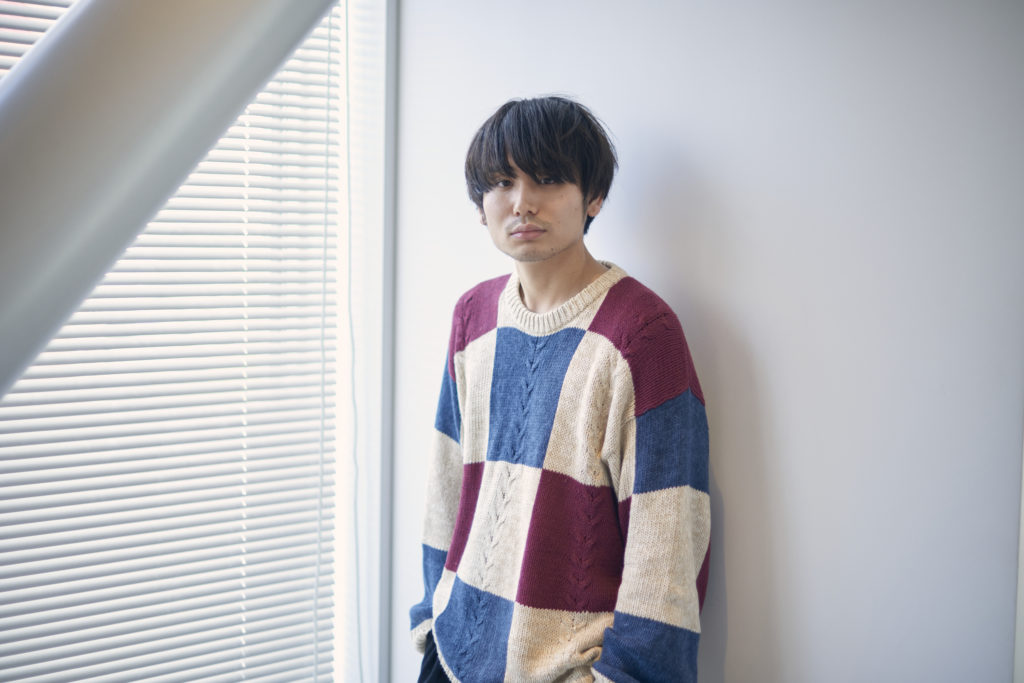Takuya Uchiyama began his career as a film director when he won the Audience Award for his debut film “Vanitas” at the 2016 PFF (Pia Film Festival). Uchiyama’s path until that point had been an interesting one: Originally, he had set out to become a stylist, but after assisting on movie sets, he realized he wanted to become a director. Later, he would go on to direct music videos for King Gnu’s “The hole” and Ken Hirai’s “#302,” which were widely talked about.
Uchiyama’s most recent project is his new film “Sasaki In My Mind,” which he worked on with actor Gaku Hosokawa. The film is originally based on a story about one of Hosokowa’s high school classmates, but was then reworked into an original screenplay. The story follows 27-year-old Yuji Ishii, who moves to Tokyo to become an actor, but lives a life of mediocrity. One day, he remembers something from his high school days: the overwhelming presence of his classmate Sasaki and friends. With a compelling personality, Sasaki seemed to fascinate and attract everyone in his orbit. But when something happens to Sasaki, his friendships gradually fall apart. Through this film, we get to know the film philosophy of Director Uchiyama, who hopes to tell people it’s okay to be uncool.
——The first film you directed, “Vanitas,” won the Audience Award at the 2016 PFF, and from there, you started seriously pursuing a career as a filmmaker. In a previous interview, you mentioned that if you hadn’t won an award for “Vanitas,” you may have given up film directing altogether. So the award was quite a big opportunity for you.
Uchiyama: At the time, I was only working a part-time job, so I had no choice but to put everything I had into “Vanitas.” So, I felt like if that didn’t work out, I may as well just move back to my hometown. Thanks to that award, I was invited to the Hong Kong International Film Festival. And foreign film festivals are unbelievably amazing places to be. I’ve had the chance to see some incredible things as a filmmaker, so I’m super grateful to be able to experience it all. My desire to bring my films back to these places is what motivates me to create my next work.
——You started with a feature-length film, and then from there you directed music videos such as King Gnu’s “The Hole” and Ken Hirai’s “#302,” videos which got people talking.
Uchiyama: King Gnu’s “The Hole” was the first music video I directed, so it’s a project that changed my life. “Vanitas” is the project that showed me I could continue to pursue a film career, but “The Hole” was what got my name out there.
I think it’s cool that some people only want to make movies, but personally, I want to be the kind of director who works on all kinds of videos, like short films, music videos, commercials, etc.
The film is based on a real person, but the story is almost completely original
——I heard the planning behind “Sasaki In My Mind” started in 2017. What made you want to turn this story into a movie?
Uchiyama: It wasn’t like I won the award in 2016 and then my work kept steadily growing–in any case, I was still working my part-time job every day, and my life hadn’t changed in any big way. It was the same for Gaku Hosokawa, who acted in “Vanitas”; we were both still living in obscurity. And then before the summer of 2017, we met at an izakaya for the first time in a while, and he was telling me a story about his classmate. He told me, “I want to make this story into a movie, even if I need to put my acting career on the line.” The story was so intriguing that I really believed I had to make it into a movie myself, so much that it had to be me or no one else. And he said, “Let’s do it together.”
——And since that original plan, you ultimately went through over 127 drafts, rewriting the screenplay many times, right?
Uchiyama: Originally, what Gaku brought wasn’t much more than a plan, so there wasn’t a solid screenplay. He had just given me the general idea that there would be a character named “Sasaki” and that he wanted to play him. From there, we decided to create it together, so we started writing the screenplay from scratch. Starting from the summer of 2017, it probably took us a bit under three years to write it. We were writing the screenplay up until the end of 2019, right before the filming, and we were even rewriting parts during the filming. So we were pretty torn until the last minute.
——Sasaki is a real person. To what extent does the film stay true to his character?
Uchiyama: It’s true that Sasaki is based on a real person, but “Sasaki In My Mind” is only inspired by him. So I thought of most of the different scenarios and characters from scratch.

——Have you ever met the person who inspired the movie?
Uchiyama: When I started the script, I thought that I should meet him, but Gaku and I decided that it was better to make the movie as an original piece. It wasn’t intended to be a piece about his life anyway. Gaku already knows him, so if anything, I thought it’d be better if I never met him. So I decided not to.
——What was the most difficult part of writing the screenplay?
Uchiyama: The process leading up to the screenplay was the hardest. With this film, it took me about a year to figure out the story behind the main character, who was played by Yuji Ishii. I think when you make a film, the research you do beforehand is the most important, so I spend a lot of time on that. I usually research and then create something like a resume for the characters, so I can get a better picture of them. But this time, I was basically making it blind, so it was a real struggle.
——King Gnu’s Satoru Iguchi is in the movie, and I felt like I saw a different side of him. Did you decide to cast him after “The Hole?”
Uchiyama: Actually, no. I had known that when Satoru was a student, he used to be into theater, acting and doing plays, so he’s someone who’s into self-expression. But this time, he actually came to the audition of his own accord. Ultimately, he ended up getting a different role than what he auditioned for.
“Sasaki In My Mind” is a project made by everyone
——You crowdfunded for “Sasaki In My Mind.” What was the intention behind that?
Uchiyama: Originally, this started as an independent project without any sponsors, so I never imagined it would become this big of an indie film. But that’s not to say I wanted to crowdfund because we didn’t have enough budget–it was more that we wanted to have control of the environment we were producing this project in. I think it feels true to this movie that through crowdfunding, we were able to receive support from a lot of people and make it happen together.
At first, we were a bit reluctant to get support from people we didn’t know. But when we tried it, I could feel the passion, how strongly the people who supported us felt, and that feeling became a driving force for us before and during the filming. When the film is released, I think it’ll strengthen our relationship with our supporters even more.
——My last question is a bit cliche, but could you tell me who you hope sees “Sasaki In My Mind,” and what message you want to send to them?
Uchiyama: It’s obvious, but I’d like as many people as possible to watch. It’s not just about the story; I also want people to feel the mindset we had when we made the film. It’s not like, “Watch this because I made it.” It’s that I want to share my feelings with everyone. When people are done watching, I want them to discuss who Sasaki is and what Sasaki means to them.
I think this movie is a movie for losers. And through this movie, I want to tell people it’s okay if they’re uncool or awkward, and encourage them to want to live another day. That’s why I want people who are bored of life or having a hard time to watch it. In particular, for people in the generation below us, who are about to go through experiences like in this movie—things will go wrong in life. And then before you realize it, they will change for the better. And that becomes a person’s life. For example, I want to tell them that even if their life is hard, it’s not a mistake.
Takuya Uchiyama
Uchiyama was born on May 30th, 1992 in Niigata Prefecture. After graduating from high school, he entered Bunka Fashion college and began working as a stylist in the film industry. Through experience, he immersed himself in the world of film, and ended his career as a stylist after graduating college. After that, he studied under Director Ryota Nakano (“The Asadas!” and “Her Love Boils Bathwater”). At age 23, he directed his first film, “Vanitas” (released November 13th), winning him the 2016 PFF Audience Award. Recently, in addition to directing music videos and commercials, he directed “Aoi, Mori” (released November 6th).
Twitter:@_takuyauchiyama

Film: “Sasaki In My Mind”
Director: Takuya Uchiyama
Screenplay by: Takuya Uchiyama, Gaku Hosokawa
Cast: Kisetsu Fujiwara, Gaku Hosokawa, Minori Hagiwara, Shintaro Yuya, Yusaku Mori, and more.
Available in theaters at Shinjuku Musashino-kan and nationwide from November 27th, 2020
https://sasaki-in-my-mind.com
Photography Yohei Kichiraku
Translation Aya Apton









